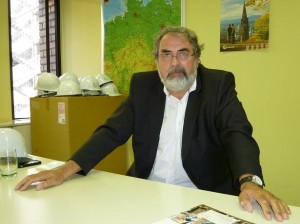 |
| Photo by Shin Yamaaki |
I had some knowledge of the subject through my ten-year experience working in Thüringen in the former East Germany, where the uranium mining corporation Wismut was located. I thought I had something to say about it.
――Wismut was decommissioned in 1990. Did the nuclear incident at Chernobyl influence the discontinuation?
I believe there was some indirect influence. For example, in East Germany, where there hadn't existed any explicit environmental movements, the Chernobyl meltdown became an occasion for much accumulated anxiety to surface, eventually leading people to question the political leadership. However, the decommissioning of Wismut was a national project that coincided with the reunification of Germany. The miners and local residents in fact still had not been informed that the mined metal had been uranium, and of course had no knowledge of the dangers they had been exposed to.
© 2010 Um Welt Film Produktionsgesellschaft |
――The film shows a variety of people in their respective relations to uranium mining: a Namibian miner who takes a meal in the midst of the powdery dust, the dangers of which he is unaware of, and a female miner who murmurs at home, “So many people get sick every month because of the filthy dust.” When asked if she knows how much radiation she has been exposed to, her silence as well as her facial expression are tragically eloquent. What was your message in the movie?
Nuclear issues tend to be considered only partially—nuclear weaponry, nuclear power, reprocessing, disposal—without a comprehensive picture. Also, the issue of mining has long been neglected and thus has deceived us. I wanted to alarm the world of such predisposed information.
――An Aborigine community in Australia first approved a particular mining operation, later realized its danger and, with support from specialists, prevented the development of another mine. This indeed reminds us, as said in your movie, “Ignorance cultivates the soil where lies flourish.” In your opinion, are the CEOs of the uranium mine ignorant or are they actually deceitful? Worse yet, are they knowing criminals?
I think they seriously believe that the problems regarding uranium mining can be somehow managed and that it provides more economic benefits, such as employment, than it does harm. The CEOs are, in that sense, faithful to their professional duty, which is to work for the interests of stockholders and the cooperation. However, undoubtedly, they manipulate information. Such corporative attitudes are well-expressed in the words of a journalist from Uranium City, a Canadian equivalent of Wismut: “We cannot obtain the information that we need nor would we be able to decipher it if given any. Ultimately, we happily accept what is given to us by pro-nuclear agents.”
――Let us hear your message in light of the accident at TEPCO’s Fukushima Daiichi Nuclear Power Plant.
The decommissioning of reactors is an emerging issue. In Lubmin, a town in Northern Germany, the decommissioning of a first-generation model nuclear plant has been going on for twenty years, but we still have no sense of how things will pan out. Meanwhile the cost accumulates year by year. In Japan too, who is going to bear the cost of reactor decommissioning that will be required in the near future? We should consider the nuclear issue facing the final phase of reactor decommissioning as well. That is my final message.
Yellow Cake: The Dirt Behind Uranium
2005-2010, Germany
Distributed in Japan by Pandra
Currently showing at Shibuya Uplink (10:15, 12:30, 14:30, 18:40) and to be screened in Osaka Ciné Nouveau from February 18 and more.
* Please contact the above theaters for updated screening times. For screenings outside Tokyo, visit here (Japanese only).
Joachim Tschirner was born in 1946 in Wittenberge in the former East Germany. He studied Aesthetics and Cultural Theory at Humboldt University, Berlin, from 1970 to 1974 and worked as a film editor from 1975. He became a film director for the production company DEFA in 1980 and founded an independent film label, UM WELT FILM in 1991. His other documentaries include: Say: Heaven. Even When There's None (1984), Canto General: The Great Song of Pablo Neruda and Mikis Theodorakis (1983), At the End, the Concert (1985), A Small Piece of Germany (1991, with Klaus Salge & Lew Hohmann), Kein Abschied - nur fort (1991, with Lew Hohmann), Maxhuette-Cycle (1987-1991), On the Seventh Day Over the Syr Darja (1992-1995), Sieben Tage - Da unten am Indian River (1995), Tapping (1993-1997), and The Aral Sea - Where the Water Ends, the World Ends (1998).
Shin Yamaaki published her first book, Tamesareta Chihō Jichi (The Challenge of Grassroots Democracy: 13 Years of Suzu, a front-line city in a proxy war on Japanese nuclear politics) from Katsura Shobō in 2007, a reportage of the nuclear-development project in Suzu City, Ishikawa Prefecture, for which she was awarded the Yayori Journalist Award and the Peace and Cooperative Journalist Fund Arai Namiko Award. Her current project focuses on Iwaishima Island in the Seto Inland Sea, where she has spent more than 190 days intermittently and been involved with the people protesting the Kaminoseki Nuclear Development for thirty years. Click here for her blog in Japanese.
This article first appeared in a Japanese political magazine, Shūkan Kinyōbi No. 882 (Febrary 19, 2012) and is adapted and reprinted on the WAN website with approval from the publisher and the author.
Original Article on the WAN Website (March 11, 2012)
Translated and adapted by Aya Kitamura
Original Article on the WAN Website (March 11, 2012)
Translated and adapted by Aya Kitamura
1 comment:
thankyou!
Post a Comment